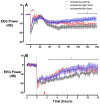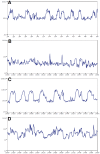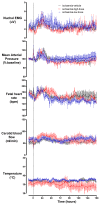Deleterious effects of high dose connexin 43 mimetic peptide infusion after cerebral ischaemia in near-term fetal sheep
- PMID: 22754366
- PMCID: PMC3382776
- DOI: 10.3390/ijms13056303
Deleterious effects of high dose connexin 43 mimetic peptide infusion after cerebral ischaemia in near-term fetal sheep
Abstract
Hypoxic-ischaemic brain injury at birth is associated with 1-3/1000 cases of moderate to severe encephalopathy. Previously, we have shown that connexin 43 hemichannel blockade, with a specific mimetic peptide, reduced the occurrence of seizures, improved recovery of EEG power and sleep state cycling, and improved cell survival following global cerebral ischaemia. In the present study, we examined the dose response for intracerebroventricular mimetic peptide infusion (50 μmol/kg/h for 1 h, followed by 50 μmol/kg/24 h (low dose) or 50 μmol/kg/h for 25 h (high dose) or vehicle only (control group), starting 90 min after the end of ischaemia), following global cerebral ischaemia, induced by 30 min bilateral carotid artery occlusion, in near-term fetal sheep (128 ± 1 days gestation). Both peptide infusion groups were associated with a transient significant increase in EEG power between 2-12 h after ischaemia. The ischaemia-low dose group showed a significant recovery of EEG power from day five compared to the ischaemia-vehicle and -high dose groups. In contrast, the high dose infusion was associated with greater secondary increase in impedance (brain cell swelling), as well as a trend towards a greater increase in lactate concentration and mortality. These data suggest that higher doses of connexin mimetic peptide are not beneficial and may be associated with adverse outcomes, most likely attributable to uncoupling of connexin 43 gap junctions leading to dysfunction of the astrocytic syncytium.
Keywords: connexins; fetus; gap junctions; hemichannels; ischaemia; mimetic peptide.
Figures




Similar articles
-
Connexin hemichannel blockade is neuroprotective after asphyxia in preterm fetal sheep.PLoS One. 2014 May 27;9(5):e96558. doi: 10.1371/journal.pone.0096558. eCollection 2014. PLoS One. 2014. PMID: 24865217 Free PMC article.
-
Connexin Hemichannel Mimetic Peptide Attenuates Cortical Interneuron Loss and Perineuronal Net Disruption Following Cerebral Ischemia in Near-Term Fetal Sheep.Int J Mol Sci. 2020 Sep 4;21(18):6475. doi: 10.3390/ijms21186475. Int J Mol Sci. 2020. PMID: 32899855 Free PMC article.
-
Connexin hemichannel blockade is neuroprotective after, but not during, global cerebral ischemia in near-term fetal sheep.Exp Neurol. 2013 Oct;248:301-8. doi: 10.1016/j.expneurol.2013.06.026. Epub 2013 Jul 6. Exp Neurol. 2013. PMID: 23838537
-
Connexin hemichannel blockade improves survival of striatal GABA-ergic neurons after global cerebral ischaemia in term-equivalent fetal sheep.Sci Rep. 2017 Jul 24;7(1):6304. doi: 10.1038/s41598-017-06683-1. Sci Rep. 2017. PMID: 28740229 Free PMC article.
-
Connexin targeting peptides as inhibitors of voltage- and intracellular Ca2+-triggered Cx43 hemichannel opening.Neuropharmacology. 2013 Dec;75:506-16. doi: 10.1016/j.neuropharm.2013.08.021. Epub 2013 Sep 2. Neuropharmacology. 2013. PMID: 24007825 Review.
Cited by
-
Anti-Inflammatory Therapies for Treatment of Inflammation-Related Preterm Brain Injury.Int J Mol Sci. 2021 Apr 13;22(8):4008. doi: 10.3390/ijms22084008. Int J Mol Sci. 2021. PMID: 33924540 Free PMC article. Review.
-
Therapeutic strategies targeting connexins.Nat Rev Drug Discov. 2018 Dec;17(12):905-921. doi: 10.1038/nrd.2018.138. Epub 2018 Oct 12. Nat Rev Drug Discov. 2018. PMID: 30310236 Free PMC article. Review.
-
Changes in Cellular Localization of Inter-Alpha Inhibitor Proteins after Cerebral Ischemia in the Near-Term Ovine Fetus.Int J Mol Sci. 2021 Oct 4;22(19):10751. doi: 10.3390/ijms221910751. Int J Mol Sci. 2021. PMID: 34639091 Free PMC article.
-
Hypoxic Preconditioning Maintains GLT-1 Against Transient Global Cerebral Ischemia Through Upregulating Cx43 and Inhibiting c-Src.Front Mol Neurosci. 2018 Oct 1;11:344. doi: 10.3389/fnmol.2018.00344. eCollection 2018. Front Mol Neurosci. 2018. PMID: 30323740 Free PMC article.
-
Connexin hemichannel blockade is neuroprotective after asphyxia in preterm fetal sheep.PLoS One. 2014 May 27;9(5):e96558. doi: 10.1371/journal.pone.0096558. eCollection 2014. PLoS One. 2014. PMID: 24865217 Free PMC article.
References
-
- Vannucci R.C. Hypoxic-ischemic encephalopathy. Am. J. Perinatol. 2000;17:113–120. - PubMed
-
- Edwards A.D., Brocklehurst P., Gunn A.J., Halliday H., Juszczak E., Levene M., Strohm B., Thoresen M., Whitelaw A., Azzopardi D. Neurological outcomes at 18 months of age after moderate hypothermia for perinatal hypoxic ischaemic encephalopathy: Synthesis and meta-analysis of trial data. Br. Med. J. 2010;340 doi: 10.1136/bmj.c363. - DOI - PMC - PubMed
-
- Thornton J.S., Ordidge R.J., Penrice J., Cady E.B., Amess P.N., Punwani S., Clemence M., Wyatt J.S. Temporal and anatomical variations of brain water apparent diffusion coefficient in perinatal cerebral hypoxic-ischemic injury: Relationships to cerebral energy metabolism. Magn. Reson. Med. 1998;39:920–927. - PubMed
-
- Williams C.E., Gunn A.J., Mallard C., Gluckman P.D. Outcome after ischemia in the developing sheep brain: An electroencephalographic and histological study. Ann. Neurol. 1992;31:14–21. - PubMed
-
- Freeman S.M., Abboud C.N., Whartenby K.A., Packman C.H., Koeplin D.S., Moolten F.L., Abraham G.N. The “bystander effect”: Tumor regression when a fraction of the tumor mass is genetically modified. Cancer Res. 1993;53:5274–5283. - PubMed
Publication types
MeSH terms
Substances
LinkOut - more resources
Full Text Sources
Other Literature Sources
Miscellaneous

